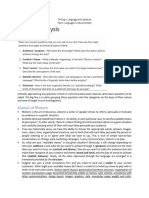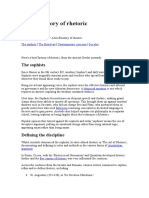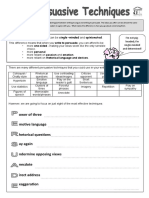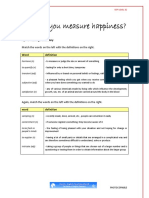0 ratings0% found this document useful (0 votes)
25 viewsYear 8 The Art of Persuasion
Year 8 The Art of Persuasion
Uploaded by
giniri6228This document discusses rhetorical techniques for persuasive language and speeches. It defines rhetoric as the art of persuasion through language. The three main pillars of persuasion discussed are ethos, pathos, and logos. Ethos appeals to credibility, pathos appeals to emotion, and logos appeals to logic and reason. The document also discusses kairos, which is deploying an argument at the right or opportune time, and decorum, which means using language appropriately for the subject.
Copyright:
© All Rights Reserved
Available Formats
Download as PPTX, PDF, TXT or read online from Scribd
Year 8 The Art of Persuasion
Year 8 The Art of Persuasion
Uploaded by
giniri62280 ratings0% found this document useful (0 votes)
25 views12 pagesThis document discusses rhetorical techniques for persuasive language and speeches. It defines rhetoric as the art of persuasion through language. The three main pillars of persuasion discussed are ethos, pathos, and logos. Ethos appeals to credibility, pathos appeals to emotion, and logos appeals to logic and reason. The document also discusses kairos, which is deploying an argument at the right or opportune time, and decorum, which means using language appropriately for the subject.
Original Title
Year 8 the Art of Persuasion
Copyright
© © All Rights Reserved
Available Formats
PPTX, PDF, TXT or read online from Scribd
Share this document
Did you find this document useful?
Is this content inappropriate?
This document discusses rhetorical techniques for persuasive language and speeches. It defines rhetoric as the art of persuasion through language. The three main pillars of persuasion discussed are ethos, pathos, and logos. Ethos appeals to credibility, pathos appeals to emotion, and logos appeals to logic and reason. The document also discusses kairos, which is deploying an argument at the right or opportune time, and decorum, which means using language appropriately for the subject.
Copyright:
© All Rights Reserved
Available Formats
Download as PPTX, PDF, TXT or read online from Scribd
Download as pptx, pdf, or txt
0 ratings0% found this document useful (0 votes)
25 views12 pagesYear 8 The Art of Persuasion
Year 8 The Art of Persuasion
Uploaded by
giniri6228This document discusses rhetorical techniques for persuasive language and speeches. It defines rhetoric as the art of persuasion through language. The three main pillars of persuasion discussed are ethos, pathos, and logos. Ethos appeals to credibility, pathos appeals to emotion, and logos appeals to logic and reason. The document also discusses kairos, which is deploying an argument at the right or opportune time, and decorum, which means using language appropriately for the subject.
Copyright:
© All Rights Reserved
Available Formats
Download as PPTX, PDF, TXT or read online from Scribd
Download as pptx, pdf, or txt
You are on page 1of 12
The Art of Persuasion
Rhetoric and all
Year 8
Lesson Intention and Success Criteria
Lesson Intention
• I will effectively identify and utilise persuasive techniques.
Success Criteria:
• Define rhetoric
• Unpack ethos, pathos, logos and kairos
• Analyse persuasive speeches
Rhetoric-Definition
• Rhetoric is the art of persuasion language.
• Writers and speakers use rhetoric to convince their
audience to do/think something.
• Rhetoric is one of the three ancient arts of discourse.
Discourse is the formal exchange of ideas in
conversation.
• Grammar, logic and rhetoric were essential to classical
education (according to Plato’s dialogues).
• These three are known as Trivium in the Middle Ages.
The
Rhetorical
Triangle
Three Pillars of Persuasion
1. Ethos
• Greek word meaning ‘character’. In terms of persuasive language, it is
an appeal to authority and credibility. Ethos is a means of convincing
an audience of the reliable character or credibility of the
speaker/writer, or the credibility of the argument.
• An ethos-based argument will include a statement that makes use of
the speaker or writer’s position and knowledge.
• According to Aristotle, we’re more likely to trust people who we
perceive as having good sense, good morals, and goodwill
Three Pillars of Persuasion (cont.)
2. Pathos
• Greek word meaning ‘suffering’ or ‘experience’, and it is used in persuasive
speech as an appeal to the emotions of the audience.
• Example: If you tell a story that draws your audience to be emotionally
involved, they are likely to be persuaded.
• If an audience is experiencing one emotion and it’s necessary to your
argument that they feel another, you can counterbalance the unwanted
emotion with the desired one.
• What are the dichotomies for the following emotions?
Anger; friendship; fear; confidence; shame; kindness; pity ; envy
Three Pillars of Persuasion (cont.)
3. Logos
• Greek word meaning ‘a word’ or ‘reason’. In rhetoric, it is an appeal to logic
and reason. It is used to persuade an audience by logical thought, fact and
rationality.
• There are two common approaches to logos: deductive and inductive
arguments
1. Deductive: build on statements to reach a conclusion
• Example: All men are mortal, and Socrates is a man, therefore Socrates
must be mortal.
2. Inductive: a probable argument based on eliminating the impossible and
ending with sound logic and fact. These are based on generalisations.
• Example: All people with a cough have a cold. Kelly has a cough. Therefore,
Kelly likely has a cold.
• List out other forms of logos in our world.
Kairos
• Kairos is the Greek word meaning ‘the right, critical or opportune moment’.
• The time in which an argument is deployed is as important as the argument
itself.
• An argument at the wrong time/to the wrong audience is wasted. Always
consider your audience.
• Example: If you wanted to persuade people to go vegetarian, the middle of a
hot dog-eating contest is probably not the right time.
• In essence, kairos asks you to consider the context and atmosphere of the
argument you’re making. How can you deploy your argument better
considering time and space? Should you wait, or is time of the essence?
Decorum
"Your language will be appropriate if it expresses emotion and character, and if it
corresponds to its subject. 'Correspondence to subject' means that we must neither speak
casually about weighty matters, nor solemnly about trivial ones... To express emotion, you
will employ the language of anger in speaking of outrage; the language of disgust and
discreet reluctance to utter a word when speaking of impiety or foulness; the language of
exultation for a tale of glory, and that of humiliation for a tale of pity and so on in all other
cases. This aptness of language is one thing that makes people believe in the truth of your
story: their minds draw the false conclusion that you are to be trusted from the fact that
others behave as you do when things are as you describe them; and therefore they take your
story to be true, whether it is so or not."
-Aristotle, Rhetoric
Define decorum based on the quote above.
•
You might also like
- Kami Export Nadia Mousaly Ethos Pathos Logos Definitions and WorksheetDocument6 pagesKami Export Nadia Mousaly Ethos Pathos Logos Definitions and WorksheetNadia MNo ratings yet
- Encyclopedia of Creativity, Invention, Innovation and EntrepreneurshipDocument2,439 pagesEncyclopedia of Creativity, Invention, Innovation and Entrepreneurshipjosselyn100% (2)
- Argumentative Essay Point of View Essay: Social MediaDocument33 pagesArgumentative Essay Point of View Essay: Social MediaLaiba FarhadNo ratings yet
- Persuasion and Its Rhetorical AppealsDocument6 pagesPersuasion and Its Rhetorical AppealsJennie Ann GrencioNo ratings yet
- NOTES 5 Logos Ethos Pathos PowerpointDocument16 pagesNOTES 5 Logos Ethos Pathos PowerpointBakhita KiaraNo ratings yet
- Big 5 and Some Stylistic DevicesDocument4 pagesBig 5 and Some Stylistic DevicesivettokolevaNo ratings yet
- Modes of PersuasionDocument4 pagesModes of Persuasionapi-330861569No ratings yet
- 06 CT ARGUMENTATION History and Basics SVDocument58 pages06 CT ARGUMENTATION History and Basics SVAnoraNo ratings yet
- Introduction To RhetoricDocument39 pagesIntroduction To Rhetoricمصطفى كاظمNo ratings yet
- A Brief History of Rhetoric: The SophistsDocument15 pagesA Brief History of Rhetoric: The SophistsJosé Miguel Najul100% (1)
- Ethos, Pathos, Logos v3Document3 pagesEthos, Pathos, Logos v3miketolNo ratings yet
- Argument, Rhetoric, and WritingDocument7 pagesArgument, Rhetoric, and WritingMaggie VZNo ratings yet
- Business Communication - Semester 2Document11 pagesBusiness Communication - Semester 2vibhor shrivastavaNo ratings yet
- Evaluating Evidence, Rhetorical Devices, Rhetorical Appeals UpdatedDocument29 pagesEvaluating Evidence, Rhetorical Devices, Rhetorical Appeals Updatedgabba.arabyNo ratings yet
- Modes of PersuasionDocument12 pagesModes of PersuasionRenaizza FuentebellaNo ratings yet
- Aristotelian ArgumentDocument58 pagesAristotelian ArgumentJosé Miguel NajulNo ratings yet
- Persuasive Strategies: Adapted by Dr. Nagwa SolimanDocument21 pagesPersuasive Strategies: Adapted by Dr. Nagwa SolimanMai EL GebaliNo ratings yet
- Techniques of ArgumentDocument18 pagesTechniques of ArgumentTech HelperNo ratings yet
- Unit 1 English Language 4 - Marta IglesiasDocument6 pagesUnit 1 English Language 4 - Marta IglesiasMartaNo ratings yet
- Three Argumentative AppealsDocument3 pagesThree Argumentative AppealsEula EalenaNo ratings yet
- Ethos, Logos, PathosDocument3 pagesEthos, Logos, PathosZakaria LahrachNo ratings yet
- Rhetorical AppealsDocument30 pagesRhetorical AppealsBianca MistalNo ratings yet
- Lecture 03Document22 pagesLecture 03Mahendran MNo ratings yet
- A Rhetorical Device Is A Linguistic Tool That Employs A Particular Type of Sentence StructureDocument5 pagesA Rhetorical Device Is A Linguistic Tool That Employs A Particular Type of Sentence StructureSilviu EnglishNo ratings yet
- Aristotelian RhetoricDocument1 pageAristotelian Rhetoricapi-443119001No ratings yet
- Public Rhetoric of Aristotle - SimplifiedDocument4 pagesPublic Rhetoric of Aristotle - SimplifiedRajesh CheemalakondaNo ratings yet
- DRR#1Document3 pagesDRR#1bellatobonNo ratings yet
- Grade 8 - Modes of PersuasionDocument33 pagesGrade 8 - Modes of PersuasionSamantha Denisse L. SoltesNo ratings yet
- Rhetoric in The Roman PeriodDocument31 pagesRhetoric in The Roman PeriodBharat DhakalNo ratings yet
- That Do Not Exist, Only Interpretations: Things Questions My AnswersDocument5 pagesThat Do Not Exist, Only Interpretations: Things Questions My AnswersTaylor Aitken100% (1)
- Introduction To RhetoricDocument20 pagesIntroduction To RhetoricDianne Jiecel CasimoNo ratings yet
- Persuasive Language Powerpoint 2011Document35 pagesPersuasive Language Powerpoint 2011api-275699532No ratings yet
- 2024 APPEALS IN ARGUMENTSDocument23 pages2024 APPEALS IN ARGUMENTSbrinokamangatNo ratings yet
- Elt 7Document8 pagesElt 7Danizelle Kaye Cadocoy BernardoNo ratings yet
- Persuasive Writing NotesDocument10 pagesPersuasive Writing Notesrickk7461No ratings yet
- RhetoricDocument3 pagesRhetoricHemera Fernanda FariasNo ratings yet
- Aoife O'Driscoll - Paper 1 - 2021Document90 pagesAoife O'Driscoll - Paper 1 - 2021serenaNo ratings yet
- Communication For Various Purposes Final Module 11-12Document20 pagesCommunication For Various Purposes Final Module 11-12jeandedios1991No ratings yet
- IBA PANG KATANGIAN AT SIMULAIN NG RETORIKA o PAGPAPAHAYAGDocument4 pagesIBA PANG KATANGIAN AT SIMULAIN NG RETORIKA o PAGPAPAHAYAGanne25No ratings yet
- Ethos, Pathos, and LogosDocument5 pagesEthos, Pathos, and LogosJuliana HoNo ratings yet
- Unit 34Document9 pagesUnit 34Alejandra Cano EstebanNo ratings yet
- It Is RainingDocument38 pagesIt Is RainingfrauleinbernabeNo ratings yet
- Ethos, Pathos, Logos Resource and Definition Guide: March 23-27 Distance Learning 8 Grade English: Persuasive SpeechDocument12 pagesEthos, Pathos, Logos Resource and Definition Guide: March 23-27 Distance Learning 8 Grade English: Persuasive SpeechQysha NagalingamNo ratings yet
- Chapter I Linguistic Means of Persuasion in Barack Obama's SpeechesDocument17 pagesChapter I Linguistic Means of Persuasion in Barack Obama's SpeechesmsflyingsquirrelNo ratings yet
- Elements of RhetoricDocument17 pagesElements of RhetoricZi Wei ZNo ratings yet
- Optional: More On The Rhetorical Canons: Definitions of RhetoricDocument5 pagesOptional: More On The Rhetorical Canons: Definitions of RhetorickiranNo ratings yet
- RetóricaDocument6 pagesRetóricaAsbel Perez100% (1)
- Ethos, Pathos, Logos: 3 Pillars of Public Speaking: Andrew DluganDocument5 pagesEthos, Pathos, Logos: 3 Pillars of Public Speaking: Andrew DlugancccqNo ratings yet
- Ethos Pathos LogosDocument8 pagesEthos Pathos LogosHafizul IdhamNo ratings yet
- HLR Copy of Skills - Non-Literary - Persuasive TermsDocument4 pagesHLR Copy of Skills - Non-Literary - Persuasive TermsJuan Pablo Van OordtNo ratings yet
- Purposive Communication 2Document16 pagesPurposive Communication 2Basil Francis Alajid0% (1)
- Introduction To RhetoricDocument18 pagesIntroduction To Rhetoricapi-252344608No ratings yet
- Introduction To Debating - Lesson 2 - Reason, Character and EmotionDocument22 pagesIntroduction To Debating - Lesson 2 - Reason, Character and EmotionJordanNo ratings yet
- The Rhetoric of Academic WritingDocument11 pagesThe Rhetoric of Academic WritingnicollevengeNo ratings yet
- A General Summary of Aristotle RethoricDocument10 pagesA General Summary of Aristotle Rethoricharsapermata100% (1)
- Rhetoric Nia SafiraDocument4 pagesRhetoric Nia SafiraNia SafiraNo ratings yet
- Persuasive Techniques IdentificationDocument6 pagesPersuasive Techniques Identificationbkhazma17No ratings yet
- Logos Ethos Pathos PowerpointDocument21 pagesLogos Ethos Pathos PowerpointBradley BesterNo ratings yet
- Ower of Three Motive Language Hetorical Questions Ay Again Ndermine Opposing Views Necdote Irect Address XaggerationDocument12 pagesOwer of Three Motive Language Hetorical Questions Ay Again Ndermine Opposing Views Necdote Irect Address XaggerationNessmaMostafaNo ratings yet
- Exercise 8 Reduction of OrderDocument1 pageExercise 8 Reduction of OrdertharunenjpNo ratings yet
- Civ02 Rulebook For WebDocument16 pagesCiv02 Rulebook For WebSee SeeNo ratings yet
- Introduction To ProbabilityDocument55 pagesIntroduction To ProbabilityNashAbasNo ratings yet
- MF203 Fhs LNT 007Document30 pagesMF203 Fhs LNT 007PikuNo ratings yet
- DiplomaDocument22 pagesDiplomamaitreyafreefireopNo ratings yet
- Lesson Plan 7 GraphicsDocument6 pagesLesson Plan 7 Graphicsapi-547761506No ratings yet
- Epc 4406 TP 4a MST-MCT Report MawadaDocument7 pagesEpc 4406 TP 4a MST-MCT Report Mawadaapi-380948601No ratings yet
- Marketing Management: Prof Seeboli GhoshDocument171 pagesMarketing Management: Prof Seeboli GhoshSeeboli GhoshNo ratings yet
- Hammad CV UpdatedDocument2 pagesHammad CV UpdatedSarfraz AliNo ratings yet
- Albumin Au400Document2 pagesAlbumin Au400Nghi NguyenNo ratings yet
- Eight Function Development From Persona To Ego To SelfDocument2 pagesEight Function Development From Persona To Ego To SelfKevin ChungNo ratings yet
- Heat TreatmentDocument6 pagesHeat TreatmentVarun KavvampalliNo ratings yet
- Pha4054902 02Document2 pagesPha4054902 02German BernalNo ratings yet
- Aec 1st Case Study DraftDocument2 pagesAec 1st Case Study DraftEUNICE NATASHA CABARABAN LIMNo ratings yet
- Case Study: Ronald Mcdonald House BC & YukonDocument2 pagesCase Study: Ronald Mcdonald House BC & YukonHaoyu HeNo ratings yet
- Selux ST Installation Manual - 304648P001Document128 pagesSelux ST Installation Manual - 304648P001ivnikonNo ratings yet
- Anna University:: Chennai - 600025. Office of The Controller of Examinations Provisional Results of Nov. / Dec. Examination, 2022. Page 1/21Document21 pagesAnna University:: Chennai - 600025. Office of The Controller of Examinations Provisional Results of Nov. / Dec. Examination, 2022. Page 1/21shohiNo ratings yet
- Level of Disaster Awareness Awareness AnDocument55 pagesLevel of Disaster Awareness Awareness AnJane EdullantesNo ratings yet
- Assure Model Instructional PlanDocument2 pagesAssure Model Instructional PlanAndrea Marie S. GayloaNo ratings yet
- Ufd of Water Treatment SystemDocument2 pagesUfd of Water Treatment SystemJepri SihombingNo ratings yet
- How Do You Measure Happiness - B1Document16 pagesHow Do You Measure Happiness - B1Krisztina BindesNo ratings yet
- Unit 1 2m 16m With Ans1 5 by Civildatas - Blogspot.inDocument19 pagesUnit 1 2m 16m With Ans1 5 by Civildatas - Blogspot.ingunaNo ratings yet
- Alr 200052Document12 pagesAlr 200052Pedro PenicheNo ratings yet
- English Grade 6Document192 pagesEnglish Grade 6felicitygikunda8No ratings yet
- Che 227 Supervized Clinical Experience I-1Document23 pagesChe 227 Supervized Clinical Experience I-1Arum ComradeNo ratings yet
- نماذج امتحانات اساسيات تمريضDocument84 pagesنماذج امتحانات اساسيات تمريضalwasam55No ratings yet
- MatchDocument4 pagesMatchLeader KidzNo ratings yet
- Silicones and PhosphazenesDocument13 pagesSilicones and Phosphazenesaanchal pathakNo ratings yet
- Solar Plant Monitoring NovemberDocument10 pagesSolar Plant Monitoring NovemberTrong TranNo ratings yet

























































































